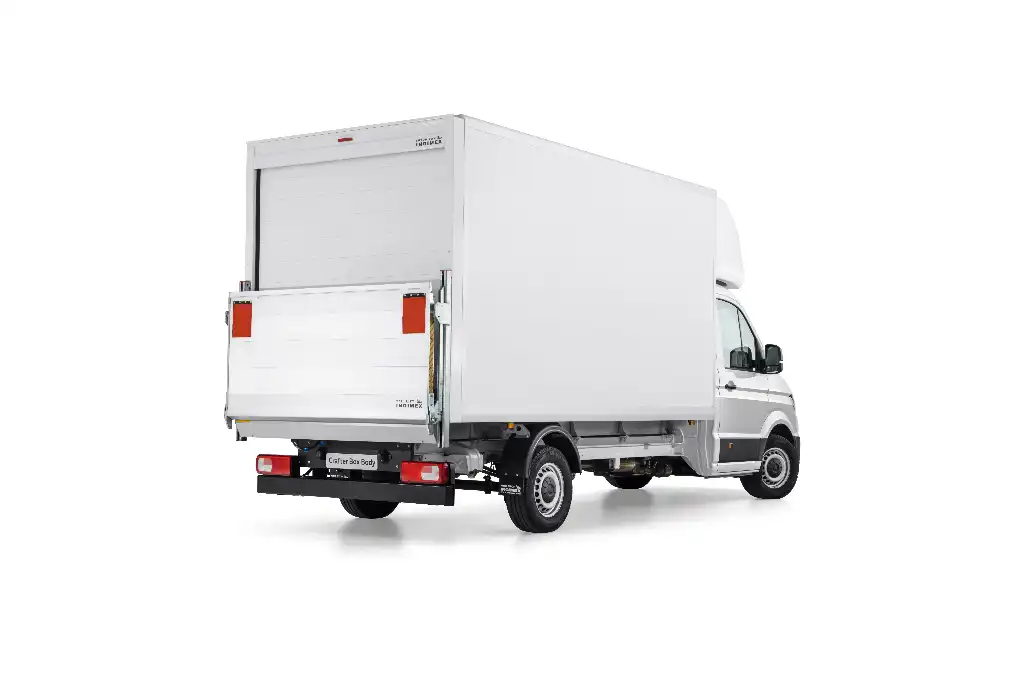
Contrary to what you might be thinking, a Luton van is not one that is built in Luton. But this guide to Luton vans will tell you all you need to know about these large and versatile vans include Luton van dimensions, Luton van weights and types of Luton van.
You’ll most likely come across a Luton van when moving house but a Luton is actually designed for any sort of dry freight. A Luton van is also known as a Luton box van and tend to have a massive load volume.
Usually based on a 3.5-tonne large van, they are about a big as a van gets and are characterised by they peaked front. That’s why they can also be called a Luton Peak van.
The peak front is an additional area that can be used for increasing storage. Or, it has been known for really long distance travel for Luton box vans to have the front section converted to a sleeping area – but you’re more likely to find that in a truck with a Luton body.
It’s not uncommon to find that most Luton vans have a tail lift fitted. Usually the sort of items being loaded into a Luton are large, unwieldy and heavy. Imagine trying to get a sideboard into a van – you’ve got a pretty high step to get it up to. A tail lift helps with loading and most rental Luton vans will have them fitted as standard.
A tail lift can come in all manner of weight lifting capacities. Be sure to read what yours is capable of, but generally they are more than capable of lifting most household items. Just be careful. Working at height is dangerous. Falling off a tail lift is no joke.
Luton vans come in a wide range of dimensions. But the dimensions of a Luton van will depend on the donor vehicle. Amongst the most popular Luton vans are Ford Transit Luton, Iveco Daily Luton and Mercedes-Benz Sprinter Luton vans.
To see the size of a particular van you can look at the van dimensions page for panel vans. Or for the most popular vans there are dedicated pages so that you can find out the Ford Transit dimensions or the Mercedes-Benz Sprinter dimensions.
This is a bit like asking how long is a piece of string. The problem is that when it comes to large Luton vans - those that are either built on oversized van chassis, or more commonly on truck chassis - there really are no limits. In fact, these are usually Luton trucks or Luton lorries, as they are built on HGV chassis.
Of course, there are limits, nothing is ever limitless in life. Here you are likely limited by the weight. But the body size of these sorts of vans can come in a variety of sizes. Generally speaking, though, a 7.5-tonne Luton will have an interior size of least 6m in length. The height can be well over 2.5m, and overall you can expect a load volume of around 32m3. That's around twice the volume of the largest panel van.
Common platforms for large Luton vans include the DAF LF and Iveco Eurocargo - both of which are trucks. The most common large Luton van won't be 7.5-tonnes, but the Iveco Daily is often used and comes close at 7.2-tonnes.
The main benefit of a large 7.5-tonne Luton van is that there is greater payload. The bodies tend to be made of lightweight plastics and when compared to a 3.5-tonne chassis you are getting around double the payload.
A typical Luton van with a 7.5-tonne GVW can carry around 3200kg, however, many have tail lifts which will reduce the payload to under 3-tonnes.
A Luton truck or van that is a 7.5 tonner will take enough for a two bedroom house. That means it's around 40 to 50 moving boxes, two or three sofas, a couple of beds, dinning room table and chairs and a few other bits.
The size of a 3.5 tonne Luton van is similar to that of a 7.5-tonne van. The key difference is that it can carry less weight.
The body size of a large Luton is surprisingly big. Typically the largest panel vans are 17m3 to as much as 20m3. But as a Luton van, which is built on a chassis cab, with a box body made from lightweight panels, you'll get 25-28m3. That's a big amount of space, and similar to a Luton truck, but the difference is weight. The payload allowance for a 3.5-tonne Luton is considerably lower - probably around 1200kg.
That makes Luton vans as 3.5 tonners more suited to moving the bulky but light items. Think of them as wardrobe movers.
A 3.5-tonne Luton van's dimensions allow it to move all manner of items, but you're probably talking about getting much of the content from a flat in there, rather than a house.
Expect the load area to be about 5m long, and around 2.2m high. There may or may not be a tail lift. Luton vans with tail lifts are more practical, but they will be able to carry even less weight.
As you'll have gathered, a Luton van's size can vary massively. On the whole they are pretty large. You'll find that most Luton vans are 20 cubic metres or more in size. They have a reasonable payload and they will be tall and wide to fit in the most awkward sizes of items.
This sounds like it could be an urban legend, but when things become popular they often pass into common usage, so we'll chalk this one up as fact.
The name obviously comes from the town of Luton, but has become synonymous with this style of vehicle because of the Bedford vans being produced there. Bedford vans with Luton bodies stuck, and the name Luton van was coined.